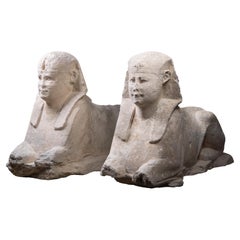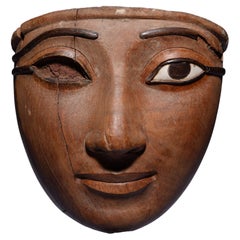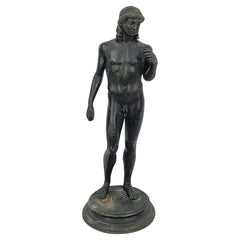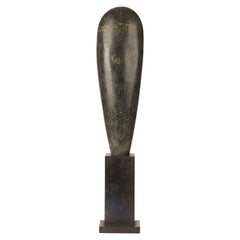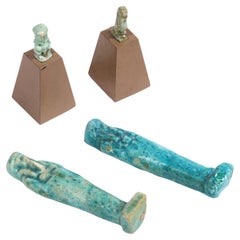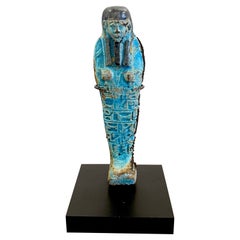North African Figurative Sculptures
11
to
1
5
5
11
11
11
2
5
1
5
1
2
1
1
1
1
Height
to
Width
to
4
4
3
2
2
6,195
11,052
3,596
3,139
1,917
1
Place of Origin: North African
Ancient Egyptian Monumental Temple Sphinxes
Located in London, GB
A pair of monumental limestone sphinxes of Pharaoh Nectanebo I, from the processional avenue of the Serapeum of Memphis, 30th Dynasty, circa 379 - 360 BC.
The sphinxes of the Serapeum have captivated travellers since Roman times. However, despite their significance, they are conspicuously absent from the collections of most major museums. Indeed, their existence in private hands is so improbable, and their imitations so numerous, that the present sphinxes were assumed to be modern copies throughout their recent ownership history. Finally recognised and conserved after an extraordinary chance discovery at a garden furniture sale...
Category
15th Century and Earlier Egyptian Antique North African Figurative Sculptures
Materials
Limestone
Exceptional Egyptian Sarcophagus Mask
Located in London, GB
Exceptionally Fine Wooden Sarcophagus Mask
Third Intermediate Period, 21st Dynasty, circa 1069-945 BC.
Acacia wood, rosewood, hippopotamus ivory
Masterfully carved from a single piece of fine-grained hardwood, the present mask is characteristic of the most exquisite funerary art made during the 21st Dynasty, and was probably commissioned for a particularly high-ranking individual.
The oval face displays a gently smiling mouth with full, outlined lips, furrows at the corners and a bow-shaped philtrum. The straight nose with rounded nostrils, the cheeks full and fleshy and the large, almond shaped eyes with heavy lids and tapering cosmetic lines, set below long, sweeping eyebrows.
Social collapse across the Mediterranean in the Late Bronze Age meant that the 21st Dynasty in Egypt was a period of great turmoil. Trade routes were disrupted, governments collapsed, and mass migration occurred. Economic scarcity meant that traditional funerary practices in Egypt were also affected, with a lack of material and financial resources leading to the reuse of preexisting material. As a result, during the 21st Dynasty, 19th and 20th Dynasty coffins changed ownership rapidly and were heavily recycled for new purposes. Tombs were also unmarked allowing them to be shared
by many people. These new practices brought forth a shift in the understanding of funerary paraphernalia. No longer important objects owned forever by the deceased, they were now simply seen as short-term transformative devices, whose symbolic and ritualistic meaning could be appropriated for others. However, paradoxically, the art of coffin-making also reached new heights during this period, and many of the richly dec- orated “yellow” coffins, characteristic of the 21st Dynasty, are remarkable works of art in their own right. Indeed, knowing that coffins were being reused throughout Egypt, the Egyptian élite set themself apart by commissioning lavish sarcophagi decorated with the images and texts meant to help guide them to the afterlife, and which would otherwise have adorned the tomb walls. As coffins were the chief funerary element which now identified the dead and allowed them a physical presence in the world of the living, their quality and appearance were of the utmost importance.
The traditional coffin ensemble was made of three parts: a wooden mummy cover, which laid directly atop the mummy, an inner coffin, and an outer coffin, both made of a lid and case. Additional decorative elements, such as masks, were carved out separately and later glued or pegged to the lids. After the completion of the painted decoration, the sarcophagus was covered in a varnish to give it its yellow colour. Gilding was sometimes used for the coffins of the high priests’ families, notably on parts representing naked skin, such as the face mask. However, some of the élite tactically avoided gilding altogether as to ensure that their coffin would not be looted.
When manufacturing the inner and outer coffins, particular attention was paid to the woodwork. Displaying the skill of the carpenter, this type of funerary art has largely remained unparalleled throughout Egyptian history. The principal wood used to craft the present mask is Acacia nilotica. The evergreen Egyptian acacia was considered sacred and said to be the tree of life, the birthplace of the god Horus, as well as symbolic of Osiris, the god of the dead and resurrection. The modelling of the face in the wood is superb, but the inlays also help mark this mask out as exceptional. Inlaid eyes and eyebrows were extremely rare and reserved to the finest and most expensive coffins. Traditionally, eyes were made of calcite, obsidian, or quartz, and eyebrows of coloured glass paste or bronze. Here, the pupils, eyebrows, and cosmetic lines are inlaid with Dalbergia melanoxylon, a rare type of wood which belongs to the rosewood genus.
In antiquity, however, it was known as Ebony of the Pharaohs, from the Egyptian word “hbny”, meaning dark timber, because of its black, lustrous appearance. An extremely dense and hard wood requiring significant skill to work with, ebony was a luxury material highly coveted by the pharaohs themselves, to make furniture, decorative and funerary objects. The wood was imported with great effort from the southern Land of Punt, most likely modern Sudan, Ethiopia, Djibouti, and Eritrea, alongside other luxury goods such as gold and ivory.
A magnificent ebony throne, recovered in the tomb of King Tutankhamun, illustrates the incredible aesthetic potential of this material and why it was so highly valued by Egyptian royalty. Only élite members of Egyptian society could have afford- ed Ebony of the Pharaoh inlays for their funerary mask.
The sclerae on the present piece were once both inlaid with hippopotamus ivory. Whiter than elephant ivory, this type of ivory is also denser, and more difficult to carve. The use of this luxury material, reputed for its gleaming appearance, enhances the lifelikeness of the eyes. For the Egyptians, hippopotamus ivory was imbued with magic powers. The hippopotamus was indeed both feared and venerated due to its aggressive behaviour. Whilst the male hippopotamus was associated with danger and chaos, the female was benevolent and invoked for protection, especially of the house and
of mothers and their children, through the hippopotamus goddess Tawaret. Thus, not only was hippopotamus ivory used as an inlay and to make practical objects, such as combs and clappers, but it was also used to make talismans like apotropaic wands or knives.
Made during a time of scarcity where few could afford made-to-order coffins, the present mask could have only belonged to one of the highest-ranking individuals in society. Undoubtedly one of the finest Egyptian coffin...
Category
15th Century and Earlier Egyptian Antique North African Figurative Sculptures
Materials
Fruitwood, Hardwood
Pair West African Incised Iron and Copper Axe Form Currency Pieces Custom Mounts
Located in Point Richmond, CA
A pair of West African incised iron and copper wire axe form currency pieces. On custom mounts. In the form of a ritual axe, which in many parts of Africa was carried over the shoul...
Category
Mid-20th Century Tribal North African Figurative Sculptures
Materials
Iron
A modelled pale turquoise glazed Ushabti, Circa 26th Dynasty 664-525BC
Located in ARMADALE, VIC
A finely modelled pale turquoise glazed Ushabti, Circa 26th Dynasty 664-525BC
Provenance: Sotheby’s London Lot 76 14/12/1981 for 725.00 Pounds sterling as part of a group lot.
Category
15th Century and Earlier Egyptian Antique North African Figurative Sculptures
Materials
Stone
Vintage Decorative Egyptian Pharaoh Statue on Marble Base, Grand Tour Souvenir
Located in Nuernberg, DE
A beautifully crafted statue of an ancient Egyptian pharaoh, I believe it is Ramses the 2nd however I am not completely sure. The statue appears to be made of copper or white metal. ...
Category
1970s Mid-Century Modern Vintage North African Figurative Sculptures
Materials
Marble, Metal
Egyptian Revival Style Figurative Brass Bookends
Located in New York, NY
Egyptian Revival style pair of figurative bookends in weighted brass
Category
20th Century Egyptian Revival North African Figurative Sculptures
Materials
Brass
Grand Tour Sphinx
Located in Dallas, TX
A late 18th century grand tour era Egyptian marble sphinx. Sphinx is sitting on attached black marble base.
Category
1790s Antique North African Figurative Sculptures
Materials
Marble
Egyptian Antique Bronze Seated Statue of Harpokrates
Located in Bishop's Stortford, Hertfordshire
An interesting and unusual Egyptian bronze seated figure portraying the youthful god Harpokrates (Horus the child). The figure sits unclothed with legs bent and both arms resting by his sides. His face is indistinctly molded with a wide nose and with a sidelock of hair. He wears a Pschent crown. The figure, which is removable, has a later carved and fitted oak throne. The figure has an all over black patina. The figure does have some antique age although may be an Egyptian revival piece and would benefit from further research. We are therefore offering this as a later example and priced accordingly.
Harpokrates was one of the most popular deities in the Egyptian pantheon. He was the offspring...
Category
19th Century Egyptian Revival Antique North African Figurative Sculptures
Materials
Bronze
Grand Tour Statue of Pharaoh Hatshepsut After the Ancient Model
Located in Montreal, QC
Grand Tour statue of Pharaoh Hatshepsut after the ancient model.
Hatshepsut was the fifth pharaoh of the Eighteenth Dynasty of Egypt and was the second historically confirmed female pharaoh, the first being Sobekneferu. The authentic ancient sculpture of Hatshepsut is located in Deir el-Bahri, Thebes, Egypt. Cast painted plaster. Provenance: The Collection of Charles de Beistegui, Château de Groussay. Charles de Beistegui (1894-1970), an enigmatic interior decorator whose passport was Spanish and whose wealth came from his family’s Mexican silver mines. Beistegui to indulge himself in the homes he decorated, such as his Chateau de Groussay...
Category
Early 1900s Egyptian Antique North African Figurative Sculptures
Materials
Plaster
Female Figurine Sculpture by Hassan Heshmat Egypt 1960s Blue Teal Stoneware
By Hassan Heshmat
Located in Stockholm, SE
Sculpture by Hassan Heshmat,
Egypt. 1960's.
Stoneware.
Unique.
Dimensions:
H: 52 cm/ 20 1/2''
Category
1960s Mid-Century Modern Vintage North African Figurative Sculptures
Materials
Stoneware
Set of Four Egyptian Antiquities, Pair of Sarcophagus Faience & Two Figurines
Located in New York, NY
This captivating authentic Egyptian Faience set was realized in ancient Egypt circa 3100 BCE. It offers two sarcophagus figurines- suggestive of miniature versions of King Tut's tomb- hand finished in a beautiful turquoise hue (a glaze created by pulverizing the stone into pigment). Additionally, the set features two figurines (one representative of the Egyptian god Anubis), and the other seemingly a depiction of one of the ruler's as a young child also in a turquoise glaze atop volumetric rhombus plinths with tapered sides in a refined terra cotta hue. Full of historical importance (and stunning as stand alone objects) this collection of Egyptian antiquities...
Category
15th Century and Earlier Egyptian Antique North African Figurative Sculptures
Materials
Faience
Related Items
Grand Tour Bronze Statue Of Dionysus
Located in Bradenton, FL
19th century Grand Tour bronze statue of the ancient Greek Dionysus. Dionysus also known as Bacchus, was the god of wine, fertility and festiv...
Category
19th Century Grand Tour Antique North African Figurative Sculptures
Materials
Bronze
Papau New Guinea Sentani Mounted Nephrite Axe, Early 20th Century
Located in Bishop's Stortford, Hertfordshire
Large and exceptional vintage tribal carved green jade/nephrite axe from Sentani, Papau New Guinea. The Axe is mounted in a custom made bronze base and is...
Category
Early 20th Century North African Figurative Sculptures
Materials
Stone
Free Shipping
H 17.72 in W 3.94 in D 3.35 in
Egyptian Carved Sarcophagus Figure
Located in New York, NY
Egyptian carved and painted life size sarcophagus figure (19/20th Cent)
Category
19th Century Egyptian Antique North African Figurative Sculptures
Materials
Wood, Paint
Two-Headed Egyptian Sphinx Sculpture
Located in Asheville, NC
This two-headed Egyptian sphinx is constructed of solid wood. The wood has been treated to take on a sandy, almost marble, finish. Unlike the Greek sph...
Category
20th Century North African Figurative Sculptures
Materials
Wood
1952 Brass Eagle Bookends by Virginia Metalcrafters
Located in San Diego, CA
Beautiful pair of brass spread-wing eagle bookends by Virginia Metalcrafters, stamped 1952. The eagle is shown with its wings fully spread and a laurel branch and bundle of arrows clutched in its left talon. The eagle clutches a Union shield across its breast. The Union shield has a chief with three stars and six stripes completing the design.
The eagle motif in décor and Folk Art has been widely used throughout our nation's history, most notably as part of our Great Seal. The founders of the United States were fond of comparing their new republic with the Roman Republic, in which eagle imagery, usually the golden eagle, was prominent. On June 20, 1782, the Continental Congress adopted the design for the Great Seal of the United States depicting a bald eagle grasping 13 arrows and an olive branch with its talons.
When Charles Thomson put together the final design for the Great Seal, he placed a bundle of arrows in the eagle's left (sinister) talon. The official description specifies the bald eagle holding "in his sinister a bundle of thirteen arrows." The thirteen arrows are tightly aligned – a symbol of "strength in unity" that's found in the traditional cultures everywhere, from the Romans to the Iroquois— in this case a nod to the unity of the original 13 colonies. William J. Loth founded Virginia Metalcrafters in 1890, under the name Waynesboro Stove Company. The company, which made ornately cast Cook...
Category
1950s Mid-Century Modern Vintage North African Figurative Sculptures
Materials
Brass
Vintage English Brass Lion and Unicorn Bookends
Located in San Diego, CA
Vintage Brass Lion and Unicorn Bookends Made in England. The Lion and Unicorn are symbols in the coat of arms of the UK. The lion represents England ~...
Category
1950s Hollywood Regency Vintage North African Figurative Sculptures
Materials
Brass
Vintage Pair of Egyptian Cream Recumbent Sphinxes 20th Century
Located in London, GB
This is a beautiful Vintage pair of French composite sculptures of Egyptian recumbent Sphinx, dating from the late 20th Century.
Each sphinx is modelled wearing a pharaonic headdre...
Category
Late 20th Century North African Figurative Sculptures
Materials
Other
Brass Modernist Deco Style Gazelle Bookends Sculptures, a Pair
Located in Miami, FL
Brass Modernist Deco Style Gazelle bookends sculptures, a pair
Offered for sale is a pair of brass gazelle art deco or modernist style bookends or ...
Category
21st Century and Contemporary Art Deco North African Figurative Sculptures
Materials
Brass
African Copper Currency Sculpture
Located in Long Island City, NY
African Copper Currency Sculpture. Dimensions: Taller: 15"H x 11.5"W Shorter: 13.75" x 10.5.
Category
20th Century North African Figurative Sculptures
Materials
Copper
Pair of Cast Brass Lion Bookends by Antonio Canova
By Antonio Canova
Located in San Diego, CA
Pair of cast brass lion bookends by Antonio Canova, circa 1940s. These lions were originally sculpted by Antonio Canova (Italian, 1757-1822) in larger scale for the tomb of Pope Cle...
Category
Early 20th Century Hollywood Regency North African Figurative Sculptures
Materials
Brass
Mini Pair of Vintage Turquoise Glazed Ceramic Foo Dogs, China, circa 1980's
Located in Chatham, ON
Miniature pair of vintage turquoise glazed ceramic Foo Dogs - molded forms - hand painted glossy glaze - unsigned - China - circa 1980's.
Excellent vintage condition - minor glaze...
Category
Late 20th Century Chinese Export North African Figurative Sculptures
Materials
Ceramic
H 4.63 in W 2 in D 1.25 in
1860 Grand Tour Bronze Statue of Place Vendome Column with Napoleon, Marble Base
Located in GB
We are delighted to offer for auction this stunning antique circa 1860 Grand Tour bronze statue of Place Vendome Column with Napoleon on top in so...
Category
1860s Grand Tour Antique North African Figurative Sculptures
Materials
Bronze
H 10.63 in Dm 3.43 in
Previously Available Items
Set of Four Egyptian Antiquities, Pair of Sarcophagus Faience & Two Figurines
Located in New York, NY
This captivating authentic Egyptian Faience set was realized in ancient Egypt circa 3100 BCE. It offers two sarcophagus figurines- suggestive of miniature versions of King Tut's tomb- hand finished in a beautiful turquoise hue (a glaze created by pulverizing the stone into pigment). Additionally, the set features two figurines (one representative of the Egyptian god Anubis), and the other seemingly a depiction of one of the ruler's as a young child also in a turquoise glaze atop volumetric rhombus plinths with tapered sides in a refined terra cotta hue. Full of historical importance (and stunning as stand alone objects) this collection of Egyptian antiquities...
Category
15th Century and Earlier Egyptian Antique North African Figurative Sculptures
Materials
Faience
H 2 in W 1.25 in D 1.25 in
Egyptian Turquoise Faience Shabti, Museum Mounted
Located in West Palm Beach, FL
Egyptian Turquoise Faience Shabti, Museum Mounted
Egypt, 300-600 BC
Dating back to 300-600 BC, this exceptional Egyptian turquoise faience shabti ...
Category
15th Century and Earlier Egyptian Antique North African Figurative Sculptures
Materials
Pottery
Ancient Egyptian Bronze Statue of Harpocrates
Located in London, GB
Egyptian Bronze Figurine of Harpocrates
Late Period, circa 664-30 B.C.
Bronze with silver inlay
Height: 23.1 cm
Harpocrates - that is, the infant Ho...
Category
15th Century and Earlier Egyptian Antique North African Figurative Sculptures
Materials
Bronze
Ancient Egyptian Tomb Oarsman in Painted Wood
Located in New York, NY
Oarsman carved of wood, originally primed with stucco and painted. This figure formed part of the crew who, some seated, some standing, manned the so-called "sun barges", models of t...
Category
15th Century and Earlier Egyptian Antique North African Figurative Sculptures
Materials
Wood
Ancient Egyptian Bronze Statue of Ptah
Located in London, GB
An Egyptian Bronze Figure of Ptah
25th or early 26th Dynasty, circa 750-600 B.C.
“For the very great one is Ptah, who gave [life] to all the...
Category
15th Century and Earlier Egyptian Antique North African Figurative Sculptures
Materials
Bronze
Genuine 220 Million Year Old Petrified Wood Heart from Madagascar // 2.93 Lb
Located in New York, NY
Approximately 220 million years old, this nearly three-pound heart has been hand-carved and hand-polished out of genuine fossilized wood and displays sumptuous red, black, brown, and...
Category
15th Century and Earlier Antique North African Figurative Sculptures
Materials
Petrified Wood
H 4.88 in W 5 in D 2.25 in
Egyptian figurative limestone architectural fragment
Located in Vosselaar, BE
A fragment of a trial piece of a relief with the upper body and head of a male figure with cropped hair facing right. New Kindom 1550-1070 bC. Acquired on the London art market 2022.
Category
15th Century and Earlier Egyptian Antique North African Figurative Sculptures
Materials
Limestone
Egyptian limestone architectural fragment
Located in Vosselaar, BE
A fragment of a rectangulare limestone panel from a larger relief with a portion of a extended arm holding a was sceptre. New Kindom 1550-1070 bC.
Category
15th Century and Earlier Egyptian Antique North African Figurative Sculptures
Materials
Limestone
Head of a Ptolemaic Queen, Perhaps Cleopatra VII
Located in Bruxelles, BE
Gray marble head representing a woman with long curly hair and idealized features, wearing a tiara in the form of a simple band. The idealized face is inspired by the models developed since the Old...
Category
15th Century and Earlier Classical Roman Antique North African Figurative Sculptures
Materials
Stone
Vintage Egyptian Revival Bronzed Metal Figural Sculpture of a Pharaoh, 20th C
Located in Big Flats, NY
A vintage Egyptian Revival figural Pharaoh sculpture offers bronzed cast metal figural sculpture depicts an Egyptian man with robe having incis...
Category
20th Century Egyptian Revival North African Figurative Sculptures
Materials
Metal
H 13.5 in W 4.5 in D 4 in
Antique Anglo Indian Architectural Model of an Arch
Located in Palm Beach, FL
Architectural Anglo Indian model of an arch crafted in carved bone. The model is complete with finials, columns and a footed plinth inlaid with exotic hardwoods and mother of pearl i...
Category
20th Century Moorish North African Figurative Sculptures
Materials
Hardwood
Egyptian Ptolemaic Period Green Faience Shabti Figure
Located in Bishop's Stortford, Hertfordshire
A very fine Egyptian pale green faience shabti figure believed to date from the Ptolemaic Dynasty 305-30BC. The figure is depicted in mummiform and wears...
Category
15th Century and Earlier Egyptian Antique North African Figurative Sculptures
Materials
Ceramic
Recently Viewed
View AllMore Ways To Browse
Indian Headdress
Musician 18th Century
Green Marble Decor
Art Deco Bronze Marble Onyx
African Sculptures African Wood Masks
American Indian Arts
Giacometti Style Sculpture
Solid Bronze Statues
Metal Torso Sculpture
Art Nouveau Lady Sculpture
Solid Gold Statue
Winged Cherubs Sculpture
Vintage Hat Display Heads
Snake E
Chariot Black
19th Century Life Size Bronze Sculpture
Equestrian Statue
Indian Head Sculpture
